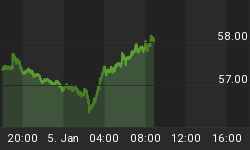RATES: Not a lot new in bond-land last week, the market just continues to grind up. 10 year yields are back under 4% even without help from the economic data last week. Perhaps stock weakness and $55 oil helped, but as per my comments from last week, and confirmed by a 0.4% decline of the CPI energy component last month, I don't believe that rising oil prices have taken their toll yet at the consumer level. So with no shortage of Treasury supply in sight, why do bonds continue to trade back under 4% while most "experts" continue to insist that yields should be considerably higher? Is it still too much liquidity, is it just the absence of inflationary pressures or is the bond market forecasting an upcoming economic slowdown?
The economic data was light last week. The headline CPI came in on expectations, but the core number was actually higher than consensus. That was not enough to change the upward path the bond market is moving in. Leading Economic Indicators declined for the fourth month in a row. That might be an item worthy of some attention. Next week will be light again in terms of significant economic data. We will get the first cut at Q3 GDP on Friday, but the market impact should be muted. It looks like the US$ is about to break to new lows, oil just keeps going to new highs each passing week, and the equity market might actually be negatively impacted by the above mentioned dynamics.
Fixed income portfolio managers staying bearish last week (RT survey unchanged at 42% bullish). Specs are long 96k contracts in the 10-year Note futures. This is bearish, except for the fact that commercials are flat and not on the other side of this trade yet. The technical picture on bonds remains constructive. Seasonals are very positive until the middle of November.
US Long Bond futures closed at 114-06, up a dollar and change last week, while the yield on the US 10 year bond declined 8 basis points to 3.97%. I recommend a slightly long position for fixed income portfolios. The Canada - US 10 year spread closed at 48, in 2 on the week. Canada is cheap to the US, buying Canadian 10 year bonds to sell US 10 year notes and pick up 50 basis points was recommended a few weeks ago. The March05 BA futures position I bought at 97 closed at 97.18, up 7 cents this past week. As expected, the Bank of Canada raised the overnight rate another 25 basis points to 2.5% last Tuesday. The upside in this contract is limited now, so I will be looking to sell this position at the 97.30 level and move out the curve. The belly of the Canadian curve outperformed the wings by 5 basis points last week, but it is still cheap to the wings. As the curve continues to flatten, the belly should continue to outperform. Overweight the belly is still the best trade idea I have. Assuming an unchanged curve, considering a 3-month time horizon, the total return for the Canada bond maturing in 2011 is the best risk weighted value on the curve.
CORPORATES: Corporate bond spreads were unchanged last week. The buy side is way long this sector. Long TransCanada Pipeline bonds were stable at 120, while long Ontario bonds were unchanged at 46.5. A starter short in TRAPs was recommended at 102 back in February. Car paper spreads were wider on credit downgrades to GM after the company reported a negative earning surprise and revised their outlook down. I am tempted to return to my earlier recommendation to short this sector again. I definitely would not get caught with a long exposure in car paper.
BOTTOM LINE: I still like bonds on a longer term, fundamental basis. An overweight position in the belly of the curve is strongly recommended. Short exposure for the corporate sector was advised since February. A long position was established in the March05 BAX futures under 97. Long Canada - Short US 10 year position was established at +50.
GENERAL COMMENTS: This issue comes to you from sunny Cairns, Queensland, Australia. The weather is superb, and it appears that there are truckloads of real estate for sale in this neck of the woods.















